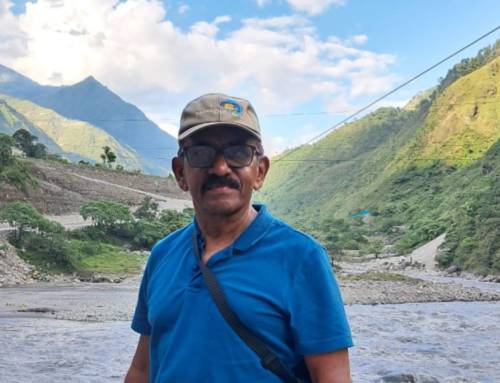Authors: Anubhav Vanamamalai, Dr. Krithi K. Karanth and Priyadarshini D.
The Wild Seve project implemented by the Centre for Wildlife Studies has been assessing the extent of human-wildlife conflict around the protected areas of Bandipur and Nagarahole. By working with residents facing the brunt of conflict, local politicians and leaders, the often overworked forest department, and conservationists, the project aims to reduce retaliation towards local wildlife.

The juxtaposition of people living alongside protected areas often escalates human-wildlife interactions to conflict.
The early phases of the Wild Seve focused on building a working relationship with local residents and the forest department. We were asking those affected to trust us with personal information about their lives, property, and livestock. Initially, the number of cases was low. Calls made to the toll-free number were recorded, and project staff alerted via text message to each one. The staff maintained notebooks, took pictures with a camera, and used GPS devices to collect data in the field. This was manually translated, digitized and subsequently analyzed. We steadily established trust and stabilised operations. As cases grew to thousands, the staff found it hard to keep up with the ever-increasing documentation and the slew of calls. The transition to a more efficient solution was essential if the project was to expand its coverage and continue to enhance its services and assistance provided.

Wild Seve staff collecting data using the traditional pen and paper method, along with GPS units and cameras.
In 2017, we decided to use a smartphone-based application for data collection and management. It had to be simple to build and configure, and understandable to the staff in the local language Kannada. Open Data Kit, a suite of open-source tools developed at the University of Washington, USA proved to be incredibly useful. Our system is comprised of three main components: a platform to create and customise forms, a smartphone interface to host the forms and collect data, and a server to receive and store completed form submissions. We also created a simple interface using open-source software R to download and run analysis on the data.

Unique ID cards issued to individuals enables Wild Seve to keep track of users over time, identify conflict-prone households, and provide targeted assistance.
We set up customizable and adaptable data collection forms that handled spatial, visual, and textual information. The forms could be configured to display questions in the field staff’s native language, while the inputted information was stored in a machine readable format. It required no coding skills and was perfectly suited for deployment in India’s remote and often poorly connected villages. Forms could be uploaded whenever a suitable cellular network was found, and staff no longer carried multiple devices.
The ODK based system was fully implemented in the third year of the project (July 2017), and proved to be a success. Field staff began to spend a lot less time with paperwork and instead were able to focus on assuaging people’s concerns, building trust with local officers and following up on each individual claim. This resulted in a marked decrease in the number of errors in the submissions as manual translations were eliminated. Overall, this increased efficiency and allowed the project to expand its coverage and services to 600 village settlements. For the scientists and managers, the near real-time nature of the submissions enabled timely response and interventions for every affected individual.
Families living around the parks employ a variety of mitigation measures to help address conflict, such as early warning systems, and protective measures such as fences, fladry, and ditches, along with long stretches of railway fencing and trenches dug by the Forest Department. While these might provide some reprieve from elephants, it doesn't stop tigers and leopards from attacking livestock tethered in sheds made of thatch and logs. It was from one such shed that Mubarak lost several of his sheep. He is a sharecropper in the village of Bankahalli, falling within the Hediyala range of Bandipur. The shed is attached to the back wall of his small house. In a year, he would lose six or seven. One instance of livestock predation had very nearly turned into a face to face encounter with a leopard. Through a series of claims made through Wild Seve, we identified Mubarak as particularly vulnerable, given the spatial location of his house adjacent to tall fields in a particularly exposed village setting. A concrete structure stands in place of his old thatch shed now, resilient to all predators that frequent his farm.

Traditional livestock sheds are made of logs or thatch which do not provide effective protection to cattle. Mubarak (pictured here alongside Wild Seve staff) is one among many who now have concrete structures protecting their livestock.
Mubarak is the first family for whom Wild Seve has helped build a predator-proof livestock shed. Wild Seve provides the design for the shed and extends partial financial support. The families’ provide funds themselves or leverage local government schemes for the remainder. So far, Wild Seve has assisted in building 42 livestock sheds, and is working with an architectural firm to create even more economical and environmentally friendly shed. Post construction, none of the assisted families have reported any incident of livestock predation. Through careful analysis and identification of families and villages lying in conflict hot-spots with multiple predation incidents, these sheds are meant to serve as models for others with livestock.

Mahadevswamy, of the Wild Seve staff documents a case of livestock predation along with the forest department.
Interactions between people and wildlife are a daily occurrence in and around India’s over 600 parks. Technology provides a simple, efficient and economical method to respond to and monitor the situation. While originally conceived to enable access to government-mandated compensation, Wild Seve has evolved to also offer effective solutions which are focused on preventing such losses in the first place. In the long term, addressing human-wildlife conflict requires the concerted and coordinated efforts of policymakers, the forest department, and most importantly, the inhabitants of these conflict-prone regions.





